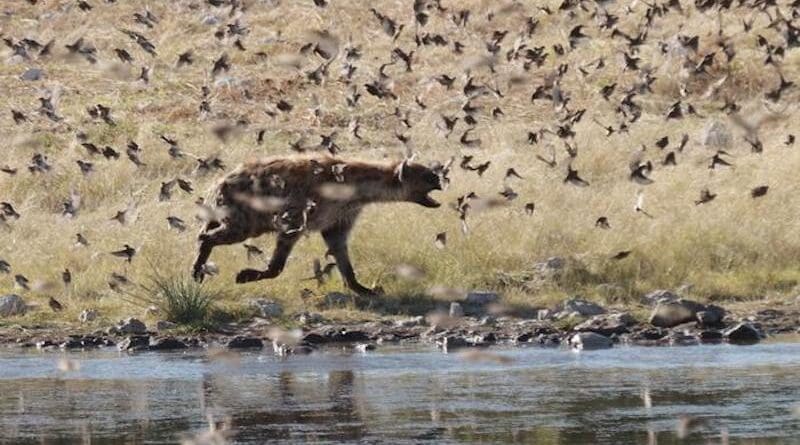Small Birds Spice Up Already Diverse Diet Of Spotted Hyenas In Namibia
The diet breadth of hyenas is matched by few other carnivores. Spotted hyenas (Crocuta crocuta) are known to hunt a variety of larger mammals such as zebras and antelopes in southern and eastern Africa – but also ostriches, flamingos, reptiles, other carnivores. They also scavenge on carcasses from giraffes to elephants and cattle. Until now very few observations of hyenas feeding on small birds were reported.
“In our paper we describe for the first time the hunting and feeding behaviour of spotted hyenas on red-billed queleas (Quelea quelea), a passerine bird known for its huge flocks, at a waterhole in the Etosha National Park in Namibia”, say Rubén Portas and Dr. Miha Krofel, scientists working for the Leibniz-IZW and the University of Ljubljana.
On two different days they observed, filmed and photographed spotted hyenas chasing flying birds or picking them from the ground or the water surface, and devouring them whole at the waterhole.
“We observed that a single hyena can catch on average one bird every three minutes”, the scientists conclude from their observations.
The scientists could draw some conclusions about the feeding behaviour of spotted hyenas from their observations.
“It adds to the known variety of the spotted hyena diet and hunting tactics, since this behaviour has not been documented before”, says Portas. “It confirms their flexibility and ability to exploit foraging opportunities and obtaining food from unusual sources. We can also provide a first estimate on the capture rates and the food intake of hyenas hunting passerine birds.”
As the observations were limited to a single waterhole, it is possible that the described foraging tactic was specific to the hyenas from the observed clan and occurred as an opportunistic response to an abundant food source, the authors say. Between May and August, thousands of wintering red-billed queleas gather at waterholes in Namibia.
Portas and Krofel regularly carry out field research on vultures, lions, leopards and hyenas and investigate carnivore-scavenger interactions and information transfer in the scavenger community for the GAIA Initiative and InterMuc projects in Etosha National Park. The GAIA Initiative is an alliance of research institutes, conservation organisations and companies with the aim of creating a high-tech early warning system for environmental changes. In several projects, the GAIA partners conduct wildlife research on selected species, their interaction and the functioning of ecosystems they inhabit.
On this basis, the GAIA scientists and engineers build and utilize high-tech interfaces to the senses and intelligence of sentinel animals in order to detect critical changes or incidents in ecosystems fast and effectively. To this end, they develop a new generation of animal tags equipped with on-board artificial intelligence (AI), a camera, energy-efficient electronics and satellite-based communication technology.

